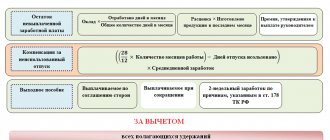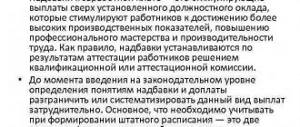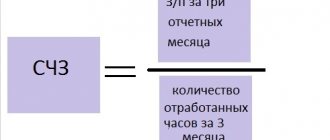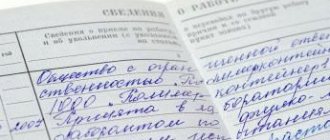Home / Labor Law / Vacation
Back
Published: 05/26/2016
Reading time: 7 min
0
2180
The legislation of the Russian Federation determines the number of days of minimum vacation. According to the Labor Code, it is equal to 28 days. However, there are extraordinary situations when an employee is entitled to more or less vacation days.
In this case, fertile ground opens up for all sorts of manipulations on the part of your employer. In order to avoid unlawful violation of their rights, every employee should be aware of the scheme for calculating vacation days.
- Legislation
- Vacation experience
- What determines the number of vacation days?
- Calculation of the number of vacation days During the working period
- After dismissal
- If you are entitled to additional leave
How is leave granted and when?
As a general rule, the duration of the main vacation is 28 calendar days for a full year worked. The employee may also be granted additional leave, for example, for special working conditions or for long work experience. That is why the duration of vacation for some employees can be up to 45 days.
The fact that the main vacation is granted for a full calendar year does not mean that the employee must work continuously for a year without the right to rest. It is established by law that annual paid leave can be granted to an employee for the first time after 6 months of his work.
Accordingly, if, as a general rule, an employee is entitled to 28 days of rest for a full calendar year, after six months he can use at least 14 days. However, by agreement with the employer, full leave can be provided in advance, that is, before the end of the calendar year; this is not prohibited by the legislator.
In this case, there is one nuance, and the employee and employer need to understand that the provision of annual paid leave is accompanied by the payment of vacation pay. And if an employee quits without working for a full year, while using the entire vacation period and receiving vacation pay in full, a difficult situation may arise between the employee and the employer regarding the return of the overpaid amount.
So, how to correctly calculate the vacation period? What day does the billing period begin?
Calculation of allotted rest days for each month worked
Based on the elementary logic that during a working year of 12 months, worked without breaks, an employee is entitled to at least 28 calendar days off, you can understand how to calculate the number of vacation days for one month worked:
The insurance period does not take into account the time of absenteeism, not being allowed to work, caring for sick relatives, etc. The same time will be deducted from the working period, which gives the right to receive annual leave.
28 days of statutory vacation / 12 months of the working year = 2.33 days of rest for the month actually worked.
The important point here is that if less than half of the calendar month has been worked, then leave for this time is not allocated by law.
If an employee has worked 15 days or more in a month, he is credited with 2 days towards his next annual rest.
In some cases, for example, for teachers due to the specific nature of their work, leave is extended by law - up to 56 days.
For example:
Borisova E. A., having got a job as a physics teacher at school No. 1 on 08/01/2021, decided to pay off on 12/07/2021.
She does not have six months of work experience at the time of dismissal, but when calculating, she should be given compensation for unused earned vacation days.
According to the law, she is entitled to an extended vacation of 56 days.
For one month worked, it turns out that she earned:
56 days/12 months = 4.67 days towards annual rest.
From 01.08. 2021 Borisova E. A. worked 4 full months and 7 days before dismissal.
For the period from 01.08.2021 to 30.11.2021, when calculating, she will receive compensation:
For 4 months X 4, 67 days = 18, 67 = 19 days (rounding is always in favor of the employee).
Seven days of December before dismissal will not affect the duration of earned leave.
If Borisova E.A. had quit after December 15, another 5 days of vacation would have been added to the 19 days (4.67 days by calculation) for December 2016.
How is the vacation period calculated?
And if the situation with the billing period for a full calendar year is clear, then what to do if the year is not fully worked out, on what basis is the number of vacation days calculated?
As the legislator established, vacation is calculated according to the following principle: for each full month worked, the employee is entitled to 2.3 days of rest (main vacation).
However, a situation may arise in which an employee works for less than a full month, how to calculate in this case? If an employee works 14 or more days in a month, a rest period of 2.3 days is accrued for such a month; if the period worked in a month is less than 14 days, no vacation is assigned for such a month.
As previously established, annual paid leave is a period of legal rest for an employee; for this period, wages must be maintained and paid to the employee in the form of vacation pay. How to correctly calculate wages for a given period?
When calculating average earnings, which periods are taken into account and which are excluded?
An employee's salary may vary throughout the year and amounts may vary significantly. On what basis then should pay be calculated for the vacation period? This amount is calculated based on the employee’s average earnings.
This average salary is calculated according to the following principle: wages for twelve months are summed up, the resulting amount is divided by 12, and then divided by 28.4 (the established average duration of a working month).
If the employee worked for less than 12 months, the salary for the period worked is summed up, divided by the number of months in the period, then also divided by 28.4. Using this formula, the average salary for one day is determined; in order to calculate the full amount, the resulting figure must be multiplied by the number of vacation days.
For example, if it is known that the employee worked for six months. Salaries were: January - 10,000 rubles, February - 10,000 rubles, March - 10,000 rubles, April - 15,000 rubles, May - 15,000 rubles, June - 15,000 rubles. The total amount for the period worked was 75,000 rubles. To calculate average earnings - 75,000/6/28.4 = 440.14. The resulting amount represents the average earnings for one day.
If the employee is given 14 days of leave, then 440.14*14= 6,161.96. This amount must be paid to the employee for the period of his vacation.
When making these calculations, it is necessary to understand that the calculation of average earnings includes all amounts received by the employee, with the exception of amounts of financial assistance that were not assigned for labor merit, for example, upon the birth of a child or on anniversaries.
Legislative regulation
According to the Labor Code, Article 115, the employer must pay at least 28 days per year. No matter what disputes this may cause, calendar days are paid and provided to the employee .
If the vacation falls on non-working holidays, then they are not included in its duration and are paid , which is regulated by Article 120 of the same Labor Code.
More information about holidays that fall on holidays can be found in this article.
Let's look at an example of how to calculate vacation:
- Manager Karpov decided to rest and wrote an application for leave from April 10 to April 17. During these 7 days there are 2 days off - Saturday and Sunday. Karpov is paid for all 7 days in a row and all of them are included in vacation.
- If Karpov writes an application for vacation for the period from May 7 to May 14, then only 7 days will be counted towards the vacation, since May 9 is a holiday .
The time that a vacationing employee spent on sick leave is not included in the calculation of vacation if he submits a sick leave certificate to the payroll department. The period of incapacity spent on vacation extends the duration of rest by the number of days of illness .
Watch a video about the nuances of granting leave:
Part-timer's leave
In addition to his main job, an employee may have a part-time job. How to combine vacations in this case? For such categories of workers, the legislator has established a certain guarantee. It lies in the fact that leave from a part-time job is necessarily granted to the employee simultaneously with leave from the main place of work, regardless of the period worked by the part-time worker.
That is, in the case of external part-time work, the employee applying for leave must, along with the application, provide a certificate from his main place of work stating that he is granted annual paid leave for a certain period. If the question concerns internal part-time work, in this case everything is a little simpler; the employee writes two applications for leave (for each position) addressed to the employer. Refusal to grant leave to a part-time worker in this situation is unacceptable.
This kind of measure is provided so that the employee can get proper rest, because it is impossible to be on vacation half-time.
Other special cases
In addition to annual paid leave, some categories of employees may be granted additional leave, as well as study leave:
- Additional vacation. This type of leave is provided in accordance with current legislation. For some categories of employees, this provision of this leave is mandatory, as evidenced by regulatory legal acts. However, the employer is not prohibited from independently establishing this type of leave for those positions that are not provided for by law. During the period of additional leave, as in the case of the main leave, wages are maintained.
- Study leave. This type of leave is provided to those persons who, along with performing their work functions, receive education at any educational institution. The employer is obliged to provide leave to this category of employees; this leave is not related to the main and additional annual leave. That is, if an employee has the right to these types of leaves, he can receive them in full for a certain period. However, there is a limitation with higher education. An employee has the right to receive paid study leave only after receiving his first higher education.
- Unused vacation. A situation often arises when an employee, having worked for a certain period of time, quits without using his right to leave. In this situation, upon dismissal, compensation for unused vacation must be transferred to the employee along with the payment. The period is calculated according to the general rule.
Previously, there were frequent cases when employees did not use the right to leave and continued to work, receiving compensation in monetary terms. Today, this practice is prohibited by law in relation to primary leave. Only days of additional leave may be subject to monetary compensation.
This rule was introduced primarily to protect workers from unscrupulous employers who do not want to provide annual paid leave.
So, the main points for calculating vacations have been considered. Having an understanding of the intricacies of granting vacations, both the employee and the employer will be able to protect themselves in labor relations.
How to apply
To go on temporary vacation, first of all, you need to determine specific dates. In most cases, they must be agreed upon with management in advance. You must write an application 14 days in advance and submit it to the HR department. Here, authorized employees must write an order addressed to the employee.
Since many people prefer to relax in the summer, companies usually create a vacation schedule, and each employee plans their free time based on it. Having a schedule has its benefits not only for company management, but also for employees. After all, in this case the likelihood of labor disputes is reduced. There is no need to discuss dates with management, there is no need to seek a compromise. In this case, the employee is confident that it is during this period of time that he will definitely be able to go on temporary leave. If there is a schedule, the manager is obliged to inform each employee about the approaching vacation date two weeks before it. The notification must be in writing. If the employer has not done this, the employee has every right to reschedule the date to any time convenient for him.
Labor Code of the Russian Federation - vacation after six months of work
This is an employee's right, but it should always be discussed with the employer. It should be noted that the application is written in free form and in handwritten form.
Although many employers allow the text of the application to be typed on a computer and signed.
The submitted sample is correctly formatted and complies with the regulations on office work.
This is important to know: Family leave for employees








